|
|
|
Sort Order |
|
|
|
Items / Page
|
|
|
|
|
|
|
| Srl | Item |
| 1 |
ID:
163319
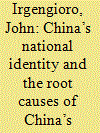

|
|
|
|
|
| Summary/Abstract |
This paper seeks to examine the People’s Republic of China’s (China) self-defined national identity and the consequences on China’s ethnic relations with its ethnic minorities. This paper argues that China’s identity is equated with the identity and culture of its ethnic Han Chinese majority—a narrative originally constructed by the Chinese state which its ethnic Han Chinese majority since indulges in. However, this hegemonic narrative is at the root of interethnic issues and tensions in China today, as further ethnic tensions stem from the resistance of ethnic minorities against Sinicization and the imposition of this “Chinese” identity against them. These phenomena thus both indicate what I term a weak “internal soft power appeal” of Han Chinese Confucian culture for ethnic minorities living in the PRC, and imply that China must adopt a different, more inclusive national identity if it were to maintain ethnic stability in the long term.
|
|
|
|
|
|
|
|
|
|
|
|
|
|
|
|
| 2 |
ID:
191783
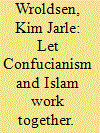

|
|
|
|
|
| Summary/Abstract |
In recent years, propaganda authorities in the Xinjiang Uyghur Autonomous Region of China have orchestrated the production of posters, banners, books, news reports, and literary magazines calling for the Sinicisation of Islam. What role is played by local Hui (Chinese Muslim) writers in the production of this propaganda? This article is based on a close reading of propaganda literature from a local county between 2010 and 2017. I show that Hui writers bargain for the preservation Hui ideological and cultural particularities. While contributing to the propaganda apparatus, they bargain to find a balance between the national call for the Sinicisation of religion and their own goal of the preservation of a Hui identity distinct from Han-Chinese culture. They argue that Sinicisation in the sense of value integration benefits the propaganda goals of the Chinese Party-State in a way that is not possible with Sinicisation in the sense of cultural and ideological assimilation.
|
|
|
|
|
|
|
|
|
|
|
|
|
|
|
|
| 3 |
ID:
147195
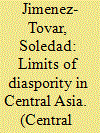

|
|
|
|
|
| Summary/Abstract |
This article shows different ways of defining, understanding and performing ‘diaspority’ in the border region of Kordai (Kazakhstan) and Tokmok (Kyrgyzstan). Taking the example of Dungan people, as the Sinophone Muslims are known in Central Asia, both academic and political definitions of the concept of ‘diaspora’ are compared. This ethnographic account problematizes Kazakhstani Shaanxi Dungan ‘diaspority’. Together with this, the political definitions of ‘diaspora’ are also analysed. I show that while in China and Kazakhstan the definitions of the Dungans as a ‘diaspora’ of ‘China’ are somewhat complementary, once the Shaanxi Dungan emic perspective is taken into account, this concept becomes rather problematic. The kinds of diaspority defined by the states involved are ways of implementing particular cultural hegemonies that legitimate the two political regimes analysed in this article. Concurrently, this dual diaspority is used by the Dungan people in distinct ways in defining their own identities. Nevertheless, I show in this article that the ‘Chinese card’ is not necessarily played by all Dungans. Moreover, there are some Dungans for whom ‘Chinese-ness’ is not even relevant.
|
|
|
|
|
|
|
|
|
|
|
|
|
|
|
|
| 4 |
ID:
147649
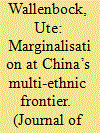

|
|
|
|
|
| Summary/Abstract |
China consists of a mosaic of many territorial ethnic groups whose historic homelands have been incorporated into the modern Chinese state, a process by which the respective populations transformed from a “sovereign or semi-sovereign people” (Bulag 2002: 9) on China’s periphery into “minority nationalities” (少数民族, shaoshu minzu). In 1950 Mao Zedong initiated the “Ethnic Classification Project” whose effect has been the marginalisation of the minority nationalities. In this paper, I explore the marginalisation of the Mongol population of contemporary Henan Mongolian Autonomous County within the Huangnan Tibetan Autonomous Prefecture in southeastern Qinghai Province. By seeking to understand how Henan Mongols deal with their socio-political and demographic marginal status, the aim of this article is to shed light on how they utilise their marginal position, and how they centralise themselves as an independent party interacting with the civilising missions of China and Tibet.
|
|
|
|
|
|
|
|
|
|
|
|
|
|
|
|
| 5 |
ID:
113770
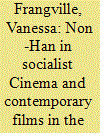

|
|
|
|
|
| Publication |
2012.
|
| Summary/Abstract |
The following article places in context cinematographic representations of the non-Han during the socialist and contemporary eras of the People's Republic of China. These two periods are characterised by the prolific production and distribution of films featuring non-Han characters and by the wealth of subjects they deal with. The aim is therefore to shed light on the analysis of contemporary productions and to understand how they coexisted with the promotion of socialist films in the first decade of the twenty-first century.
|
|
|
|
|
|
|
|
|
|
|
|
|
|
|
|
| 6 |
ID:
139453
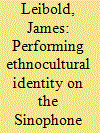

|
|
|
|
|
| Summary/Abstract |
This article explores what happens to the Chinese Party-state’s notion of minzu (nationality, ethnicity or ethno-national identity) in the vastness of cyberspace. The idea that the People’s Republic of China (PRC) comprises 56 distinct yet united minzu groups has encapsulated and circumscribed the performance of ethnocultural diversity in mainland China over the last 60 plus years. In this article, I seek to demonstrate how the Internet helps to loosen the Party-state’s grip on ‘Chineseness’ and its related categories of identity, opening up new spaces for the articulation of a wide range of ethnocultural subject positions that both self-define, mediate and, at times, even transcended minzu-ness. At the same time, however, the fractured and transitory nature of these online congregations renders them largely inconsequential when faced with a powerful and authoritarian Party-state and its robust regime of minzu classification and minzu-based policies inside the PRC.
|
|
|
|
|
|
|
|
|
|
|
|
|
|
|
|
| 7 |
ID:
099701
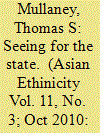

|
|
|
|
|
| Publication |
2010.
|
| Summary/Abstract |
This article proposes a new understanding of the Ethnic Classification project (minzu shibie) undertaken in China's southwesternmost province of Yunnan in 1954 - a project in which social scientists and Communist Party cadres set out to determine which of the dozens, if not hundreds, of minority communities in the province would be officially recognized by the state. Specifically, this article argues that ethnologists and linguists played a far greater role in the Classification and early Chinese Communist governmentality than is typically assumed. The Chinese Communists did not teach themselves how to 'see like a state,' to use James Scott's formulation, at least not when it came to the fundamentally important problem of ethnic categorization. To the contrary, the history of the Classification project is one of an inexperienced Chinese state that was able to orient itself only by observing the world through the eyes of its social scientific advisors. The 'mentality' within early Chinese Communist Party (CCP) 'governmentality' was, in the case of the 1954 Ethnic Classification, in large part the mentality of the comparative social sciences.
|
|
|
|
|
|
|
|
|
|
|
|
|
|
|
|
| 8 |
ID:
151469
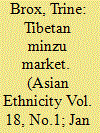

|
|
|
|
|
| Summary/Abstract |
In downtown Chengdu a pocket of Tibetan culture has sprung up: a Tibetan market where Tibetans and Han Chinese meet to buy and sell ethnic minority products. Pointing to how Tibetan migration to Chengdu has contributed to the growth of a vibrant ‘minzu market’ attracting Tibetan and Han Chinese merchants, customers, Buddhist devotees, and voyeurs, this article presents novel understandings of the ethnic goods market in urban Chengdu. The article first explores the growth of the market, which is the result of a history of political and economic reforms, increased mobility, and religious revival. Second, it maps the market infrastructure according to the ethnicity of the shopkeepers and the commodities that are traded. Although there is still a clear ethnic division in the market, this article also documents the emergence of Han Chinese market participation in forms of trade that have historically been dominated by Tibetans.
|
|
|
|
|
|
|
|
|
|
|
|
|
|
|
|
|
|
|
|
|